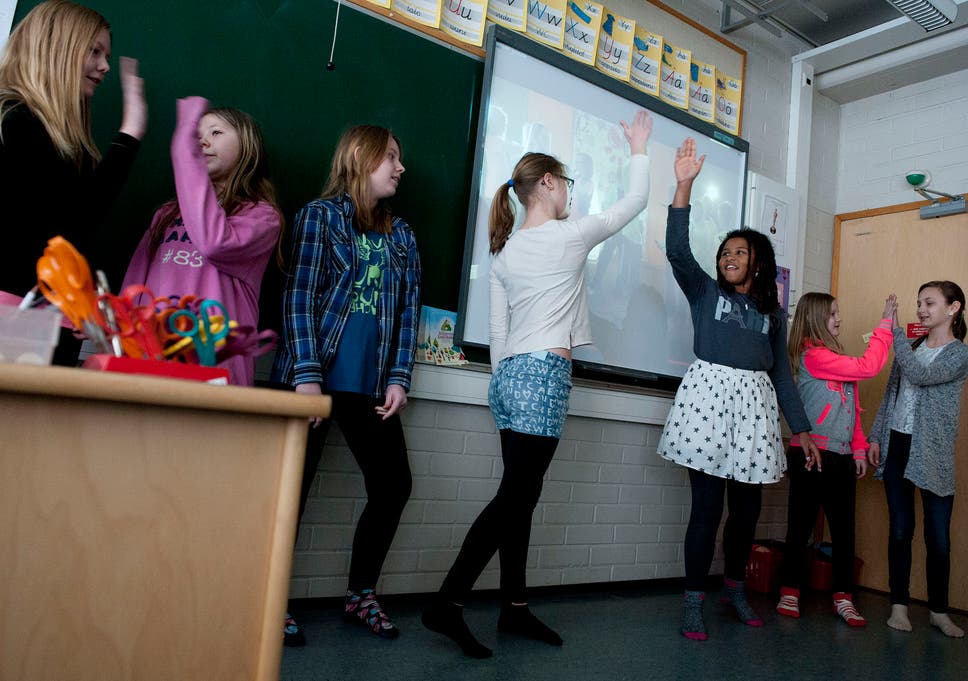Finland schools: Subjects scrapped and replaced with 'topics' as country reforms its education system
With Finland radically reforming the
way its children are taught, Richard Garner visits Helsinki to find out
if the teachers approve
Richard Garner |
| Pupils at Siltamaki primary school perform a rap as part of their cross-subject learning ( Jussi Helttunen ) |
For years, Finland has been the by-word for a successful education system, perched at the top of international league tables for literacy and numeracy.
Only far eastern countries such as Singapore and China outperform the Nordic nation in the influential Programme for International Student Assessment (PISA) rankings. Politicians and education experts from around the world – including the UK – have made pilgrimages to Helsinki in the hope of identifying and replicating the secret of its success.
“This is going to be a big change in education in Finland that we’re just beginning,” said Liisa Pohjolainen, who is in charge of youth and adult education in Helsinki – the capital city at the forefront of the reform programme.
Pasi Silander, the city’s development manager, explained: “What we need now is a different kind of education to prepare people for working life.
“Young people use quite advanced computers. In the past the banks had lots of bank clerks totting up figures but now that has totally changed.
“We therefore have to make the changes in education that are necessary for industry and modern society.”
Subject-specific lessons – an hour of history in the morning, an hour of geography in the afternoon – are already being phased out for 16-year-olds in the city’s upper schools. They are being replaced by what the Finns call “phenomenon” teaching – or teaching by topic. For instance, a teenager studying a vocational course might take “cafeteria services” lessons, which would include elements of maths, languages (to help serve foreign customers), writing skills and communication skills.
More academic pupils would be taught cross-subject topics such as the European Union - which would merge elements of economics, history (of the countries involved), languages and geography. There are other changes too, not least to the traditional format that sees rows of pupils sitting passively in front of their teacher, listening to lessons or waiting to be questioned. Instead there will be a more collaborative approach, with pupils working in smaller groups to solve problems while improving their communication skills.
Marjo Kyllonen, Helsinki’s education manager – who will be presenting her blueprint for change to the council at the end of this month, said: “It is not only Helsinki but the whole of Finland who will be embracing change.
“There are schools that are teaching in the old fashioned way which was of benefit in the beginnings of the 1900s – but the needs are not the same and we need something fit for the 21st century.”
The reforms reflect growing calls in the UK – not least from the Confederation of British Industry and Labour’s Shadow Education Secretary Tristram Hunt – for education to promote character, resilience and communication skills, rather than just pushing children through “exam factories”.
Even in Finland, the reforms have met objections from teachers and heads – many of whom have spent their lives focusing on a particular subject only to be told to change their approach.
Ms Kyllonen has been advocating a “co-teaching” approach to lesson planning, with input from more than one subject specialist. Teachers who embrace this new system can receive a small top-up in salary.
“We have really changed the mindset,” he said. “It is quite difficult to get teachers to start and take the first step… but teachers who have taken to the new approach say they can’t go back.”
Early data shows that students are benefiting too. In the two years since the new teaching methods first began being introduced, pupil “outcomes” – they prefer that word to standards – have improved.
Meanwhile, the pre-school sector is also embracing change through an innovative project, the Playful Learning Centre, which is engaged in discussions with the computer games industry about how it could help introduce a more “playful” learning approach to younger children.
“We would like to make Finland the leading country in terms of playful solutions to children’s learning,” said Olavi Mentanen, director of the PLC project,
If it does, how will the rest of the education world react?
Case study: Finnish approach
It is an English lesson, but there is a map of continental Europe on the whiteboard. The children must combine weather conditions with the different countries displayed on the board. For instance, today it is sunny in Finland and foggy in Denmark. This means the pupils combine the learning of English with geography.
Welcome to Siltamaki primary school in Helsinki – a school with 240 seven- to 12-year-olds – which has embraced Finland’s new learning style. Its principal, Anne-Mari Jaatinen, explains the school’s philosophy: “We want the pupils to learn in a safe, happy, relaxed and inspired atmosphere.”
We come across children playing chess in a corridor and a game being played whereby children rush around the corridors collecting information about different parts of Africa. Ms Jaatinen describes what is going on as “joyful learning”. She wants more collaboration and communication between pupils to allow them to develop their creative thinking skills.
No comments:
Post a Comment